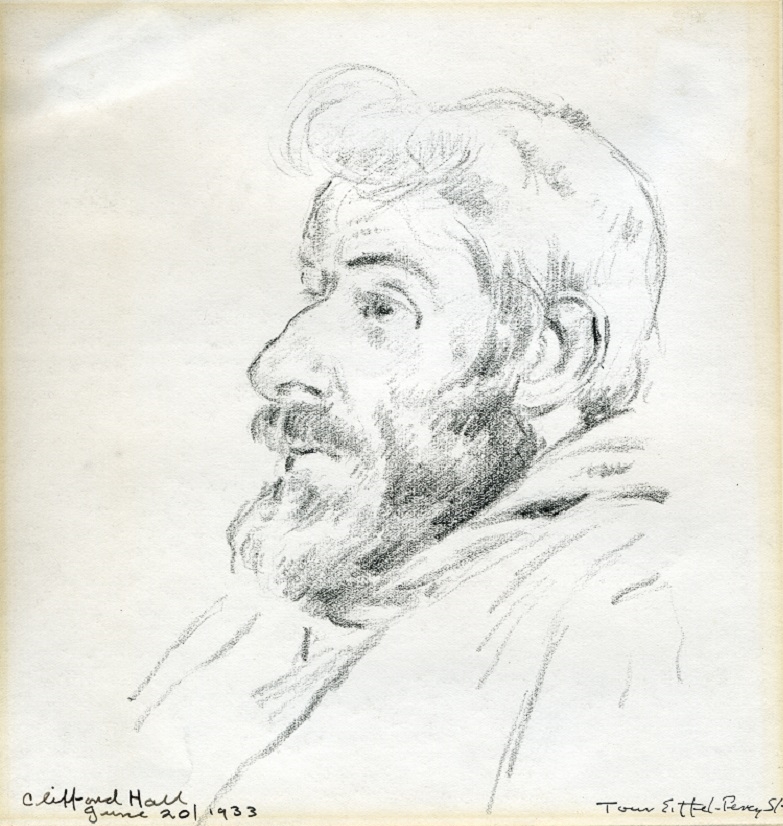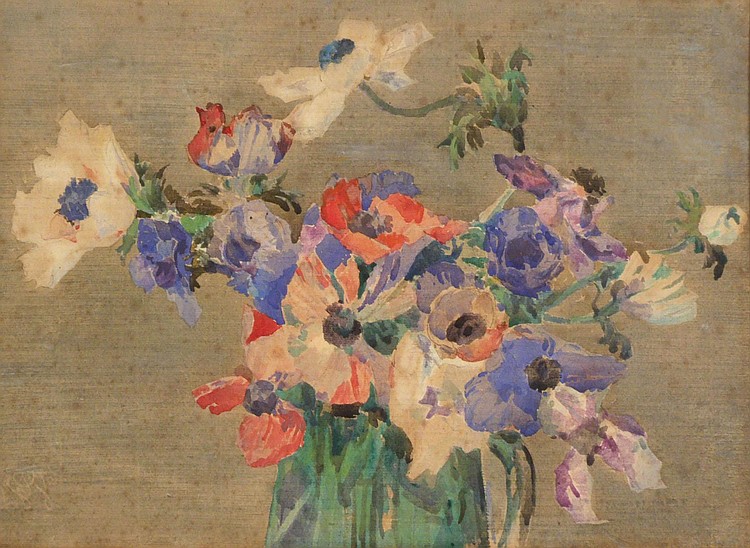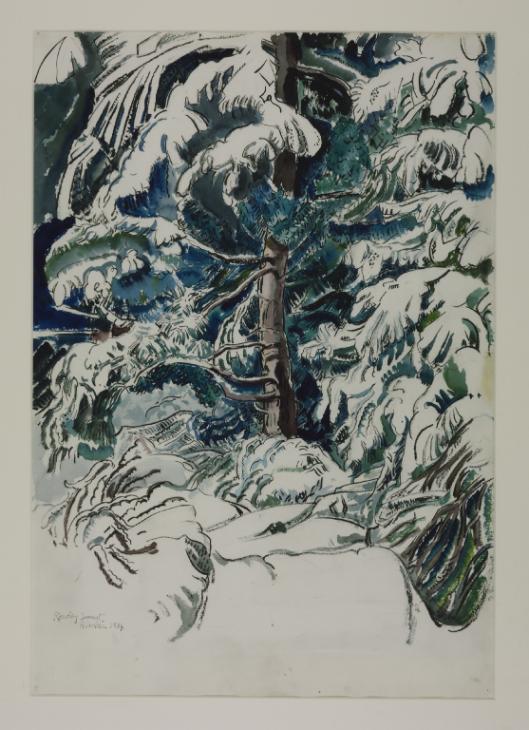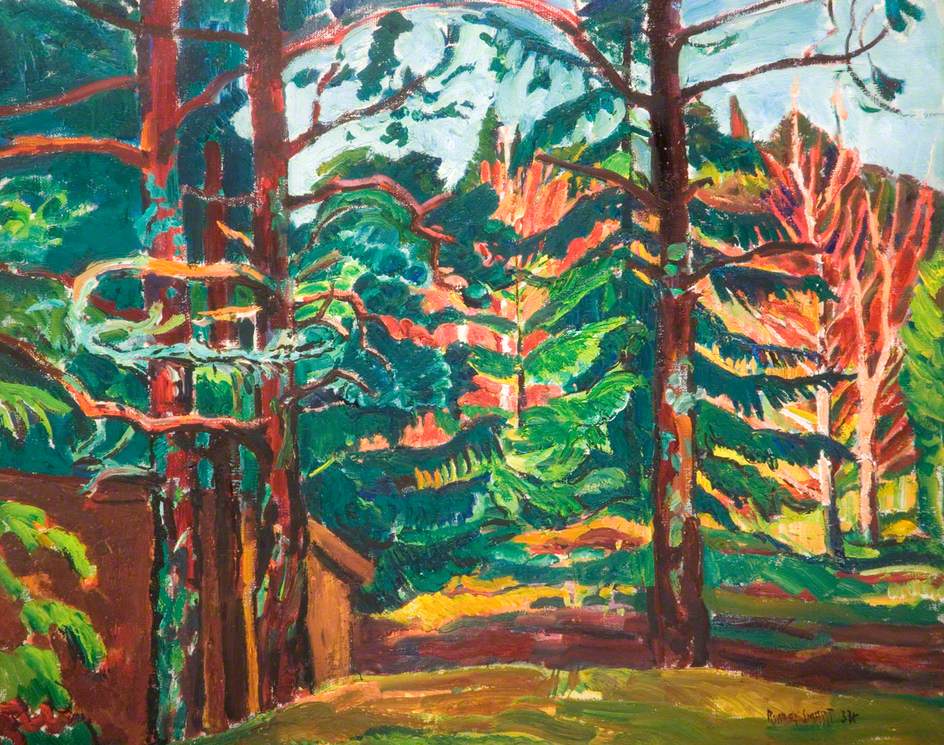


The prospect of a change had cheered Rowley. He was happy and full of plans. His doctor had told him that he could take a little whiskey now and again and he had a quarter bottle in his room. There were several people there and we drank to the success of the journey. Then some idiot suggested 'just one' at the Fitzroy. I tried to tell Rowley that he had a hard day in front of him. I would get the others away and he could settle down and have a good sleep. And Ruth should have backed me up. I offered to stay with Rowley whilst she went with the others, but some devil in her insisted that Rowley came with us.
'He was feeling better' she promised: he would 'only drink one whiskey.'
No one seemed to realize how ill Rowley was, and he was inclined to be in a wilful mood himself, so Ruth had her way and we went to the Fitzroy. That in itself need not have been fatal for the Fitzroy closed at 10.30, but in the bar we inevitably met Nina Hamnett * and she was full of a club just opened near the Scala Theatre, the Blue Mask.
* For Nina Hamnett, artist and bohémienne, see her Laughing Torso (Constable, London 1932) and Marjorie Lilly's Sickert: The Painter and His Circle Elek, London 1971). A protegée of Sickert, she lent Clifford Hall Sickert's letters to her, which, anxious for their survival, he copied. They are quoted in Miss Lilly's book. JH
'Let's all go there!'
'No,' I said, 'you go. Rowley is off to Spain tomorrow. I will take him back to the Eiffel now.'
But it was no good. Ruth wanted to see the club and Rowley must go with her, and it wasn't far away. And to the Blue Mask we went. He only had a little to drink but it was sufficient, and the excitement, and coming out of the over-heated basement in which the club was situated did the rest. When he got back to the Eiffel he had a serious haemorrhage. He was too weak to be moved next morning, so he stayed on there, and the pictures he had told me he was going to paint in Spain were never painted.
When he recovered a little Rowley used to get Ruth to bring him bunches of flowers which she arranged on the little table near his bed; and he painted a few delightful watercolours of them whilst he was lying propped up with pillows. Sometimes he wrote. Odd bits about cats and dogs. He began a skit based on the exploits of Evans of the Broke. The papers were full of his doings just then. He also amused himself writing out a series of names for public houses and one very interesting fragment about himself and Homer, and the competitions they used to have in the old Montparnasse days, drinking 'knock outs'.*
* 'I was not content to drink just drinks that made me blind, but as I went on I found I wanted "knock outs". I used to sit with my "boozing companion" Homer Bevans and we had two tumblers into which we put crème de menthe, Pernod, rum, fine, then maybe gin, white or red wine or any other thing that occurred to us such as Picon or almost anything. Then we would see which went out first. If we stood the first without a collapse we had a second and I think it was known to run to a third…. I think my reason for not realizing I was a hopeless drunkard was because in spite of all this I was generally able to get up quite early, 8 or 9 o'clock, and work as though nothing had happened.' - Rowley Smart.
I saw him once or twice every week and made a few sketches of him in lithographic chalk. One day when we were alone he gave me a watercolour inscribed to Marion and myself. He had painted it from memory since he had been at the Eiffel. 'Take it,' he said, 'before Ruth sees it. I want you to have it.'
One day he told me some girl had turned up saying she was his daughter. 'What did you do?' I asked.
'I gave her a picture and sent her away,' he replied vaguely. The incident evidently had not impressed him.
He owed Stulich money for his room. Stulich, the fat wheezy Austrian who ran the Eiffel, was a good-hearted fellow. Everyone owed him money. The restaurant was nearly always empty now and his establishment seemed to be dying slowly. Diners seldom came to the once famous restaurant on the ground floor with dozens of pictures crowding the walls - pictures by practically every well-known artist of the day, all friends and sometime patrons of the Eiffel restaurant. Times had changed. The peace wasn't working as planned and Europe was unsettled. Artists were the first to suffer. Sales had never properly recovered since the slumps of 1928 -9.
It is, I believe, characteristic of TB patients that they retain, almost to the end and in spite of suffering, a firm belief in their eventual cure. The disease in its early stages tends to encourage this attitude in them, and Rowley was just like the rest. He was doomed. I knew it. No one could have failed to see it in his face. He probably knew it himself but if he did he never said so to me. He endured his illness with courage. He was seldom in low spirits and he painted whenever he felt strong enough. He reached maturity in his work in the last two years of his life, reached it in spite of terrible health.
His old friend Doctor Stross helped him in every way, but he could not give him strength, nor could he prevent the inevitable progress of disease. Rowley fought hard. His spirit was magnificent, and his love of his work seemed to get greater as the time given him to live shortened.
When I went to see him and found him so full of determination to live and go on working I almost felt he would pull through after all, but his nervous cerebral vitality was powerless to heal the wasted ill-used body that was at last beginning to wear out.
Yet another attempt, and this time he goes to Sweden, to Ruth's people, and from there to a little wooden house far away from any town and built on the edge of a great forest. His letters from there speak of the loneliness, the silence of winter, with deep snow everywhere. He is so weak that he is unable to get up for days on end but 'Ruth looks after me'. Yet his letters from Sweden are not miserable - they still breathe something of his old vitality.
Whilst he was in Sweden a large representative collection of his work was opened in Manchester. It was a great success, and the final seal was set upon it when a false report of the artist's death in Sweden was published by the English newspapers. That Rowley got a great deal of cynical amusement from the affair was evident from the letter* he wrote me describing it.
* Dear Cliff, Thank you for your letter, for amusing change of bath scene(sic). There hasn't been very much to write about "down in the forest nothing stirred" until we got a phone call from the Swedish rep of the Daily Sketch asking about my death. Then phone calls came all day from various papers, English, Swedish, Stockholm, Gothenburg - last thursday, Manchester Guardian, Feb 22, gave a long obituary notice of my death. I got a copy this morning. How the hell it has come about I cannot think as we had no correspondence on the matter and one would think such a paper as the Manchester Guardian would be certain before publishing such a thing. Well all these papers ringing up it appears to be making a great fuss. We had interviewers and camera men out and a darn fine interview with photographs in The Swedish Morning News. Will send you a copy and other press about me in other daily paper here. It has kept Ruth very busy answering the phone. How they got our address, specially phone number, I cannot make out, we are not in the book. It's all a mystery to us from beginning to end. Rowley.
In 1934 he returned to England, still with Ruth, and they settled in a little cottage at Longnor near Buxton. It seemed that Sweden had done him a little good after all, although he was still terribly weak.
Marion and I had gone to Paris. I wanted to paint some pictures for an exhibition and I promised that we would spend a few days with Rowley when we got back. We were in Montmartre. I had little desire to revisit Montparnasse although I did go there once. The Dôme was still crowded, and I thought I recognized the 'Duchess' but I couldn't be sure. All was the same, yet strangely different, and I was aware of many ghosts. I was glad to return to the Butte.
One morning of a sunny day in the summer of 1934 the maid brought me a letter addressed in Ruth's large scrawly hand. As I puzzled out her quaint spelling I seemed to feel that Rowley was dead. I turned a page and read, 'Rowley passed away very peaceful.'
At the time I do not recollect having any feeling of shock. I had expected the news for so long, and I knew what a misery life had become for him. I remember feeling sad that I had not seen him again, and wishing that I was back in England. But there was nothing I could do for him now. I got my paint-box, easel and canvas and went along the rue Lepic to the Place du Tertre. I set up the easel and completed the picture I had started a few days before. I kept thinking of Rowley but I painted well.
Rowley had left everything - his only possessions were his personal belongings, his paintings and an old fur lined coat that Doctor Stross had given him - to Ruth, and immediately after the funeral she began to quarrel with his family. I know nothing about these quarrels, only that they occurred, for she told me about them herself. She left Longnor and came back to a room in the Eiffel. Both the Leicester Gallery and Tooth's had approached her and suggested having a memorial exhibition of Rowley's paintings. She was very confident arranging things but finally she came to me and asked me to arrange the show at the Leger Gallery. I subsequently gathered that she had tried to be too clever. She had played one gallery off against the other and had finally lost them both.
The ROWLEY SMART MEMOIR -10
A sketch of Rowley Smart by Clifford Hall. Drawn on 20th June 1933 at the Eiffel Tour Hotel in Percy Street, London.
Flowers in a Jug, watercolour by Rowley Smart. Possibly one of those Rowley did while he was bed-ridden in the Eiffel Hotel in 1933.
Pinewoods Under the Snow ,1934, by Rowley Smart. Now in the Tate Gallery Collection.
Inscr. ‘Rowley Smart Hindäs. 1934’ b.l.
Pen and watercolour, 22 1/2×15 5/8 (57·25×39·75).
Presented by Dr Barnett Stross 1944.
Coll: Purchased from the artist on his return from Sweden by Dr Stross 1934.
The artist spent the winter of 1933–4 at the Swedish village of Hindäs, near Gothenburg, one of the chief winter sports centres of the region. Although in poor health he painted some twelve watercolours and two oil paintings during his stay.
Swedish Landscape, 1934, oil painting by Rowley Smart. Now in the Keele University Art Collection.



